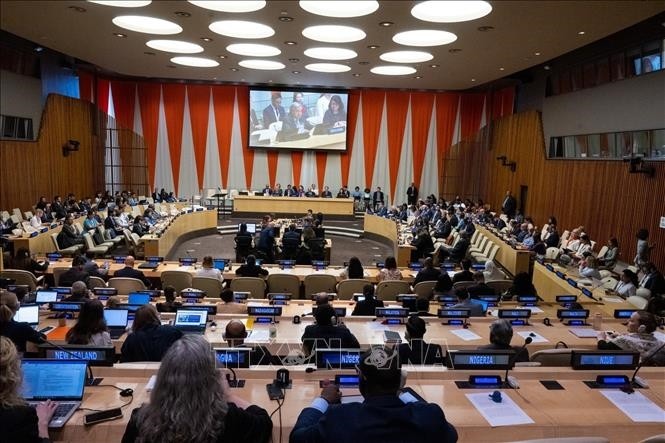(VOVWORLD) -The UN General Assembly on Monday adopted the Treaty on the conservation and sustainable use of marine biodiversity outside national jurisdiction (UN High Seas Treaty). The document strengthens the system of documents based on the 1982 UN Convention on the Law of the Sea on the management of seas and oceans, ensuring sustainable development for all countries.
 The UN adopts a historic agreement for conservation and sustainable use of biodiversity, UN headquarters in New York, June 19, 2023. (Photo: Xinhua/ VNA) The UN adopts a historic agreement for conservation and sustainable use of biodiversity, UN headquarters in New York, June 19, 2023. (Photo: Xinhua/ VNA) |
The Treaty shows the political determination of UN members to reach an agreement on marine biodiversity protection.
A mechanism for sharing marine resources fairly
UNCLOS 1982 specifies that the sea is an international area, except for parts included in a country’s exclusive economic zone, a territorial sea, the internal waters of a state, or the archipelagic waters of an archipelagic state.
The sea beyond all countries’ exclusive economic zones and the seabed beyond the continental shelf is the high seas and is not under the jurisdiction of any country. The high seas are open to all states. There they have the freedom to fish, and the minerals are their shared heritage. The exploitation of minerals must abide by a licensing mechanism and profits are shared by all countries.
But UNCLOS 1982 does not deal with one type of resource, and that is the genetic resource of marine species who live in offshore waters. Only the most developed countries and private companies have the technology and financial resources to collect marine genetic resources, study them, and use them to generate a profit. There is no international document stipulating an obligation to share or conserve those resources.
The High Seas Treaty recognizes a fundamental principle that marine genetic resources are the common heritage of mankind and benefits from marine genetic resources should be shared fairly with all nations.
For the first time, digital data on marine genetic resources is considered a "digital asset" whose benefits should be shared by all mankind through a mechanism defined in the Treaty.
This document marks a compromise between countries with different interests in conserving and exploiting marine genetic resources outside national jurisdictions. It addresses building capacity, transferring technology, and equitably sharing the benefits from exploiting such resources.
Very few sea areas are protected, and pollution, acidification, and overfishing are growing threats. The Treaty sets a goal from now to 2030: each year the world needs to protect 11 million square kilometers of ocean. The Treaty also calls for the creation of protected areas in international waters, which will serve as a foundation for national, regional, and global cooperation and action at sea.
Global efforts to protect marine environment
The High Seas Treaty is the third document on enforcing UNCLOS 1982, following the 1995 Agreement on Migratory Fish Stocks and the 1994 Agreement on Part XI UNCLOS regulating management and exploitation of the international seabed.
UNCLOS members consider adoption of the Treaty a triumph of multilateralism and of global efforts to combat trends that are harming the ocean. The High Seas Treaty will strengthen UNCLOS, the constitution of the oceans, the comprehensive legal framework for all activities at sea.
This is a new milestone in international law which contributes to the UN Decade on marine science for sustainable development and the 14th millennium goal on sustainable conservation and use of the oceans, seas, and marine resources.